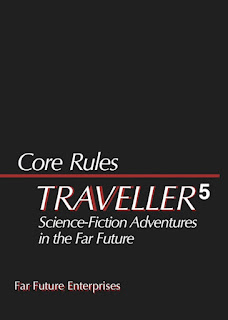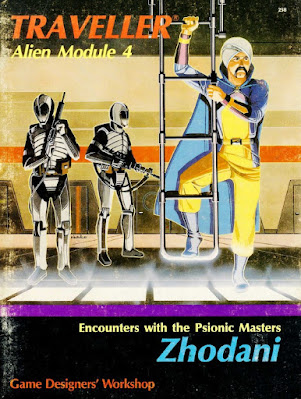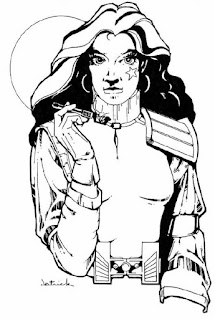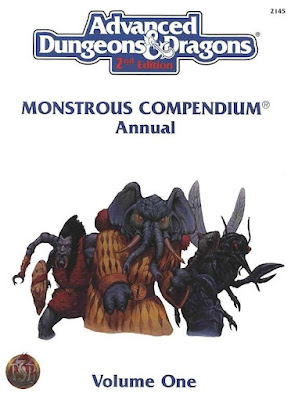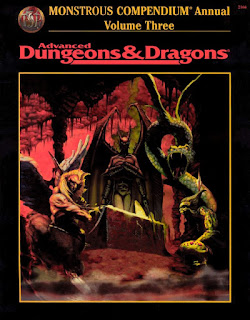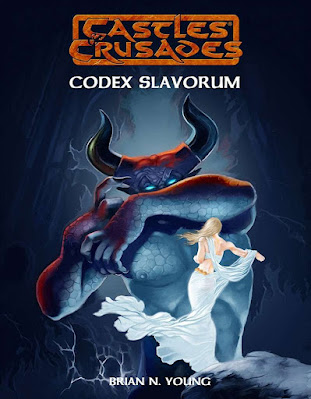Traveller 2nd Edition was first released in 2016. A revised update was released in 2021 and called the "2022 Edition." Both are the same rules though the 2022 update has a few improvements in layout and editing. For this review I am just going to consider the 2022 version and notes from the 2016 version.
Traveller Core Rulebook Update 2022
PDF. 266 pages. Full-color covers and interior art. Bookmarked and hyperlinks table of contents.
Traveller is experiencing a renaissance of sorts. We live in time where old-school games are really popular, sci-fi is having a new golden age (have you seen all the Star Treks we now have?) and Traveller is riding that wave. The new Traveller is best seller on DriveThru with the 2016 version a Mithral bestseller and the 2022 version a Platinum bestseller as of this writing. I also know my FLGS sells the books hand over fist. One of the reasons I wanted to do my deep dive into Traveller now was because of all of this.
So how is the 2022 Edition?
In a word it is gorgeous.
Mongoose, back in the early d20 boom, earned a bit of a reputation of a "spaghetti publisher" as in "throw a plate of spaghetti against the wall and see what sticks." As time went on their reputation improved. These days they get a lot of credit for not just having solid books, but also serving the d20 bust. Though some less than perfect editing sneaks in. The 2016 edition seemed to have this problem; at least that is what I have read online. Both books had high-quality color art, there are some pieces in the 2016 edition I actually like a little better, but in general, I am pretty happy with what I see. Happy enough to wish I had grabbed the physical books when I was last at my FLGS.
What about the rules?
The book is similar in many ways to Mongoose 1st Edition, but enough differences in layout and organization. For the first time, the designer did NOT try to invoke the feeling of old Classic Traveller. This is a GOOD thing. To attract new players they needed to make this a new game.
Introduction
This covers the various reasons why you might want to play Traveller and the different ways to play. I was hoping that among the examples of Star Trek and Starship Trooper they would include the most British of all Traveller shows, "Blake's 7." Which always was my goto example.
There are some suggested books to read such as Traveller Companion, High Guard, The Third Imperium, and more. I don't have those so I can't comment on them here. What it does tell me that this version of Traveller is set in the Third Imperium. So that is something to look forward too.
We get some game and dice conventions and descriptions of the Tech Levels.
Traveller Creation
Character creation is next as expected. This follows much along the lines of all Traveller versions. You roll your six abilities/characteristics. We are back to our standard six from Classic Traveller with the same point spread and averages. The CCP is still here too.
You pick your background skills and then move to the next phase. There are good flow charts for character creation and the character sheet is annotated. You go into your pre-career (aka school) and then move to your career.
Like the first edition, careers are laid out with face pages so everything you need for a career is at a glance.
This is quite helpful really. The careers supported in this core rules are Agent, Army, Citizen, Drifter, Entertainer, Marine, Merchant, Navy, Noble, Rouge, Scholar, and Scout. There is an extra "career" that of Prisoner. Possibly to do that epic Stainless Steel Rat or Farscape adventure.
Various benefits and of course mishaps occur, leaving you with extra cash, some property or medical debt.
There are some Skill Packages now. There is a push here to get all the players and characters working to gether to make sure there is cohesion.
We then get some examples of Alien species. The Aslan and the Vargr.
Skills and Tasks
This chapter is combined as it really should be. The system is basic which is what you want. The character rolls a 2d6 and need to get greater than an 8 to succeed. There are various Die Modifiers added and the Target number (the "8") can be be altered depending on the task difficulty. There are example throughout which works well. An "Impossible Task" for example would require 16 or more rolled on the check. There are also levels of success and failure. So if the roll is missed by -6 that is an "Exceptional Failure." A roll of 6+ over the target number is an "Exceptional Success."
The amount of time spent on a skill check can alter the results and there are opposed checks as well.
The rest of the chapter covers all the skills, their specialities and descriptions.
Combat
Combat is a always separate and it is a special case of a skill check. What I do like about this system is that combat can rely on STR or DEX as appropriate and is not hard-coded like say D&D. For example Initiative can be modified by DEX or INT.
The combat phase is broken down into Significant, Minor, and Free actions. You can do one Significant and one minor action per round or three minor actions. You can perform anynumber of Reactions or Free Actions as permitted. What can be done in these actions is detailed. Attacking an opponent is Significant action, as is giving orders (Leadership). Minor actions are things like aiming, reloading, changing stance.
Damage is discussed and it is very deadly.
Encounters and Dangers
This combined the old Encounters and Animal Encounters chapters of Classic-era Travellers. There are all sorts of environmental dangers, diseases, high and low gravity situations, radiation, falling and so much more. Hmmm. Maybe best just to stay on your homeworld. To quote Leonard McCoy from the 2009 Star Trek movie "Space is disease and danger wrapped in darkness and silence."
Animals are discussed and even a few examples are given.
NPCs are also presented with the ubiquitous d66 tables of quirks, motivations and more that Traveller fans love.
Equipment
Covers the economy briefly and plenty of things to spend your precious few credits on. The list here is not highly different. What is different here is the new level of art added to the lists. Descriptions of arms and armor are paired with great color art of these items. More than that there are tech items, medical equipment, computers, and survival gear. Various toolkits are also described such as Planetary Sciences and Psionicology Toolkits.
And of course guns.
Each bit of equipment comes with a TL rating.
Vehicles
Cover most moveable craft that are not Starships. Each one gets a TL rating, an associated skill needed to operate, speed factors, crew/pilot and of course cost. Nothing is free in the Imperium.
Spacecraft Operations
A mostly alphabetical listing of everything (mostly everything) that can go on in a ship.
Space Combat
Similar to other versions and the combat chapter above. This details how ships can fight including movement, targeting, and firing phases. Along with damage and reactions. The chapter is not large but remarkably detailed.
Spacecraft Construction
I think I would have put this chapter before combat. Mayb put combat after Common Spacecraft.
Distinctions are made between interplanetary and interstellar spacecraft. Like character creation, there is a helpful flowchart.
Common Spacecraft
I rather love this chapter. This lists all sorts of spaceships with their details and a full color picture and some deck plans. This is also laid out so many of the ships have all their details on the facing pages.
Many of these ships are found in previous versions of Traveller too. So it adds a nice bit of continuity to it all.
Psionics
Stuck near the end is psionics again. There are talents and powers and the Psion Career. I have always liked the Psionic powers section in Traveller, but this one really makes me want to play one. The Careers are all numbered 1 through 12 with the "Prisoner" at 13 (Navy for example is 8). The Psion career is appropriately numbered "X."
Trade
Covers basic trade between the worlds/systems/colonies. There is a huge d66 list of Trade Goods to be used by Referees.
World and Universe Creation
This chapter feels more like Classic Traveller than the others. Sadly no equations to apease the math geek in me but a lot of information all the same. The section is not huge and I a sure there are additional books for more worlds out there. But there is enough here to get you started.
Index
The index is comprehensive and hyperlinked.
Unlike previous versions of Traveller there is no included adventure here.
--
Ok. What can we say here at the end? Or in other words who should buy this Traveller and what does it have over other Editions/Versions?
Who Should Buy This?
Much like D&D is synomous with Fantasy Roleplaying, Traveller is synomous with SciFi Roleplaying. IF you want to try science fiction out then for me the obvious first step is to see what Traveller is doing.
Traveller 2nd Ed 2016 vs. 2022
Both corebooks are still on the market now. They are the same system. I have both and while the rules are largely the same the organization of the 2022 version is much better.
Classic Traveller vs. Mongoose Traveller 2nd Edition
Ah. The old-school vs. new-school debate. We live in a time where not only you can get new Traveller in print you can get old Traveller in print as well. Which one should you play? I think the choice comes down to experiences. Both games really let you play the same game. Both games are fun. Both games take on some basic assumptions but largely leave the rest of the universe to your imaginations.
IF you started with any version of Traveller and enjoy that, then stick with that, but certainly check this one out. IF you have never played any version of Traveller before then the Mongoose 2nd Edition, 2022 version is the one to get. You can buy it at DriveThruRPG or your FLGS.
Mongoose Traveller vs. FFE Traveller
We owe a lot to Far Future Enterprises for getting all the Traveller books from 1977 up to today scanned and added as a PDF to both their website and to DriveThruRPG. That is a huge debt we owe them. However, I can't exactly recommend Traveller 5 over Mongoose's version. There might be content in the FFE Traveller 5 that I could port over. But I think to show my appreciation for what they have done, I'll keep buying the older Traveller materials.
In the end, for me, Mongoose Traveller 2nd Edition is, right now, the best Traveller I can buy.
I'll make an effort to grab a print version the next time I am at my FLGS. Right now there is no Print on Demand version for the 2022 edition.
This would be the nominal end of my Traveller reviews, but not so fast. There is still a THIRD way to play "Traveller" that is active and in print today.








